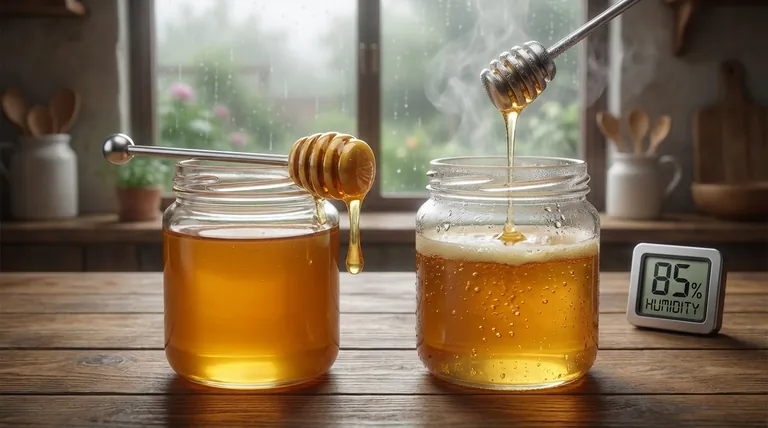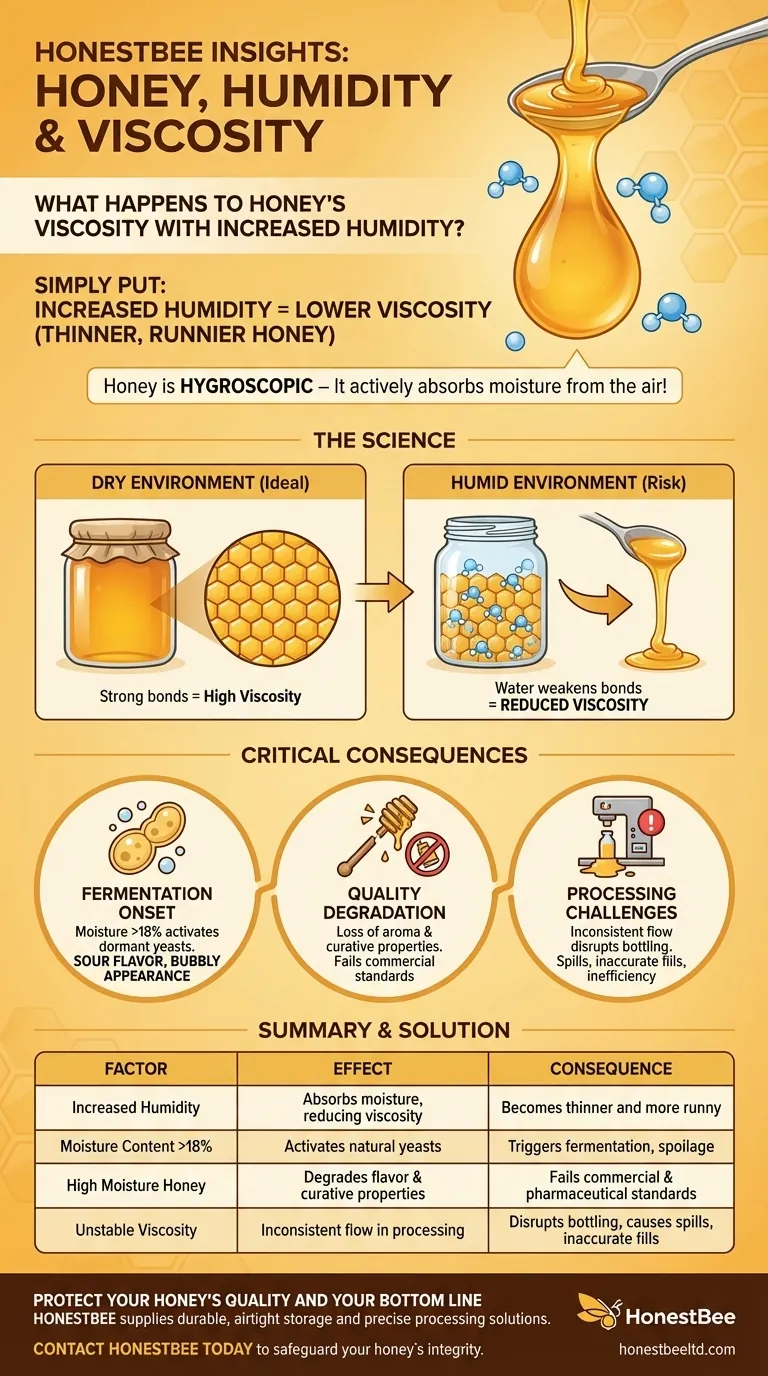Simply put, increased ambient humidity reduces honey's viscosity, making it thinner and more runny. Honey is a hygroscopic substance, which means it actively absorbs moisture directly from the air. This absorption of water is the direct cause of its change in consistency and has significant consequences for its quality and stability.
The relationship between humidity and honey's viscosity is not just about texture. It's a critical indicator of the honey's stability and commercial value, as moisture absorption is the primary trigger for fermentation and quality degradation.

The Science Behind Honey and Humidity
The interaction between honey and the air around it is governed by a fundamental chemical principle. Understanding this is key to properly handling and storing it.
What "Hygroscopic" Really Means
Honey is a supersaturated solution of sugars. Due to this high sugar concentration, it has a natural tendency to seek equilibrium with its environment.
In a humid environment, the air contains more water molecules than the honey does. As a result, honey will actively pull water from the air onto its surface and absorb it.
How Moisture Reduces Viscosity
Viscosity is a measure of a fluid's resistance to flow. In honey, this high resistance is created by the strong bonds between its complex sugar molecules.
When honey absorbs water, the water molecules get in between the sugar molecules, weakening those bonds. This interference allows the sugars to slide past each other more easily, directly reducing the honey's overall viscosity and making it feel more liquid.
The Critical Consequences of High Moisture
A change in viscosity is the first sign of a more serious problem. The absorbed moisture triggers a cascade of undesirable chemical and biological changes.
The Onset of Fermentation
Raw honey contains natural, osm tolerant yeasts. At low moisture levels (typically below 18%), these yeasts remain dormant due to the high sugar concentration.
When moisture content rises, it creates a more hospitable environment for these yeasts. This can initiate fermentation, a process where yeasts consume sugars and produce alcohol and carbon dioxide, giving the honey a sour, "off" flavor and bubbly appearance.
Degradation of Quality and Usability
Fermented or high-moisture honey is considered spoiled. It loses the characteristic aroma, flavor profile, and even the curative properties that make it valuable.
This degradation makes the honey unsuitable for many commercial applications. For instance, it is often rejected by the pharmaceutical industry and fails to meet the quality standards for high-grade table honey.
Challenges in Industrial Processing
Consistency is paramount in automated bottling and packaging. The viscosity of honey dictates how it flows through pumps and filling nozzles.
Just as processors adjust machinery for temperature-related viscosity changes, an unexpected drop in viscosity from humidity absorption can disrupt the filling process. This leads to inaccurate fill volumes, spills, and inconsistent product packaging, impacting efficiency and profitability.
Common Pitfalls to Avoid
Understanding the risks associated with viscosity changes is crucial for anyone handling honey, from a beekeeper to a large-scale bottler.
Low Viscosity Is a Red Flag
While runny honey might seem easier to pour, if the cause is humidity, it's a clear warning sign. This change indicates that the honey's moisture content is rising, placing it at imminent risk of spoilage.
The Stability Threshold
The stability of honey is directly tied to its water content. Even a small increase can be the difference between a shelf-stable product and one that ferments. This makes controlling humidity during storage and processing a non-negotiable requirement for quality control.
Making the Right Choice for Your Goal
Your approach to managing honey's viscosity depends entirely on your objective.
- If your primary focus is long-term storage or preservation: Your goal is to prevent moisture absorption at all costs by using airtight containers and storing them in a dry environment.
- If your primary focus is commercial processing and bottling: You must actively control both temperature and ambient humidity to ensure a consistent viscosity for accurate, repeatable, and efficient filling operations.
- If your primary focus is ensuring product quality: You should view a sudden decrease in viscosity as a critical warning sign of moisture absorption, prompting immediate inspection for potential fermentation and spoilage.
Ultimately, managing honey's viscosity is about protecting its fundamental integrity from the hive to the consumer.
Summary Table:
| Factor | Effect on Honey | Consequence |
|---|---|---|
| Increased Humidity | Absorbs moisture, reducing viscosity | Becomes thinner and more runny |
| Moisture Content >18% | Activates natural yeasts | Triggers fermentation, spoilage |
| High Moisture Honey | Degrades flavor & curative properties | Fails commercial & pharmaceutical standards |
| Unstable Viscosity | Inconsistent flow in processing | Disrupts bottling, causes spills, inaccurate fills |
Protect Your Honey's Quality and Your Bottom Line
For commercial apiaries and beekeeping equipment distributors, inconsistent honey viscosity due to humidity is more than an inconvenience—it's a direct threat to product quality and operational efficiency.
HONESTBEE supplies the durable, airtight storage solutions and processing equipment you need to maintain precise moisture control. From bulk storage tanks to efficient bottling systems, our wholesale-focused operations provide the reliable tools to prevent spoilage and ensure a consistent, high-quality product.
Contact HONESTBEE today to discuss your specific needs and discover how our beekeeping supplies can safeguard your honey's integrity from the hive to the consumer.
Visual Guide

Related Products
- Heavy Duty 304 Stainless Steel Honey Dipper
- Inverted Squeezable Honey Jar with No Drip Flip Top Cap for Easy Pouring
- 0.5T Capacity Honey Dehumidifier Dryer with Vacuum Heating and Thickening Filtering Machine
- HONESTBEE 3-Frame Manual Acrylic Honey Extractor
- High Quality Honey Dehumidifier Dryer Thickening Machine for Beekeeping



















